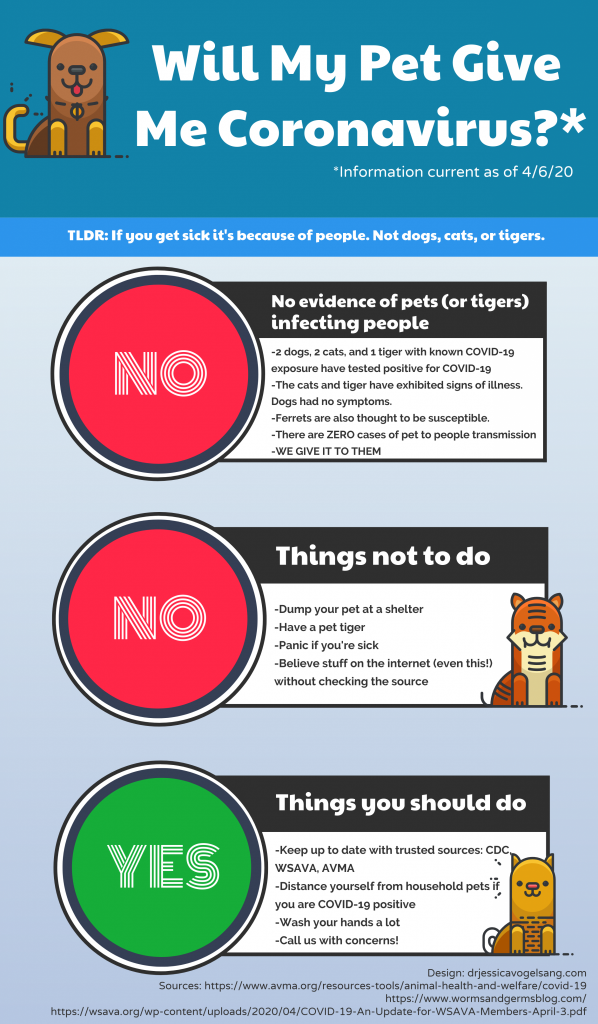How to social distance with your pet during COVID-19 quarantine
Previously, I’ve written about the few animals who have tested positive for the coronavirus that causes COVID-19. So far, it’s been a few dogs, a few cats, mink/ferrets (pretty similar!) and a few big cats.
Since then, the Centers for Disease Control (the most important resource to get your Internet advice from – when in doubt, yes, trust an .edu and.gov website, please) issued social distancing recommendations for pets.
As a veterinarian, it’s likely a major precaution, as remember, pets get COVID-19 from us, and it’s unlikely that we get it from them!

So, how do we social distance with our pets? I talked about this with Dave Lee (no relation) on WCCO radio below.

Most importantly, the ways to social distance from pets include:
- Don’t own a big cat like a tiger, lion, etc. (No, for real. Despite what Tiger King says, we veterinarians and animal advocates never recommend this).
- Keep your cats indoors during this whole thing! Why? Because cats already have their own type of coronavirus called FIP. But this one, COVID-19, can definitely affect cats and more importantly, we are really worried that it can get into our feral cat population, resulting in a chronic population of exposed animals!
- Keep your dog on a leash, 6 feet away from others!
- No dog parks where you a random dog could run into you and your dog.
- Don’t let your dog or cat interact with anyone outside of your family or environment.
What about if someone in the household is sick with COVID-19?
- Try to have that sick or positive COVID-19 person quarantine in their own room and NOT handle the pet at all.
- If that is not an option, make sure to use a mask, gloves, and PPE if available to feed and care for the pet. Wash your hands before and after handling.
- Do not directly bring your pet to the veterinarian if you are positive or anyone in your household is positive/exposed to COVID-19. If possible, have someone else bring them (and call in advance to schedule this).
More importantly, please know you do not have to abandon, surrender or give up your pet during this time. You can see this important infographic from @Pawcurious too!

Most importantly, be safe. And keep your family – two-legged and four-legged alike – safe!


After having surgery for SCC, my 15 year old cat bit off half of her tongue making it impossible for her to eat unless she is force fed via a syringe. I feed her baby food and a prescription food recommended by her vet.
I was given her by a person that had used her for breeding purposes only. She is a purebred Persian, was seven when I got her, and I was told she had had 14 litters. I have no idea if the previous owners smoked or not. Her dental hygiene has been fine.
Her surgery was March 12. Even though I feed her every two to three hours, I notice she is not putting on weight. She still drools a brown liquid. The vet had said that he got all of the tumor, but I’m not too sure he did. He has not discussed euthanasia. She is not taking any pain meds. She seems comfortable, but because cats are so stoic, I’m not sure. The vet suggested a feeding tube. Again, I feel like I’m just prolonging her misery. Also, I noticed her stools are very black and are getting loose.
With this information, would you please give me some direction ?
I’m so sorry – that sounds terrible. It sounds like she needs a feeding tube – that would be more humane than force feeding her. I do not ethically believe in force feeding adult pets. It sounds like her quality of life is deteriorated if she doesn’t want to eat. I would discuss humane euthanasia with your veterinarian. I’m so sorry.
I am glad the the COVID-19 virus is down in numbers. I own a dog boarding and day care business and it was very difficult for us because a lot of our pet owners stayed home. We really had to adapt. This was something that we had to figure out. We really did not have a lot of reports on pets getting COVID, but we had a lot of our staff get it because of all the pet sits we had to do. It was tough.